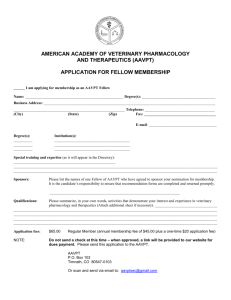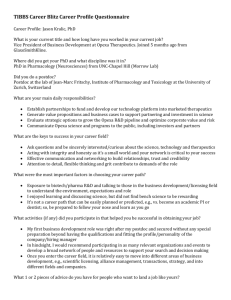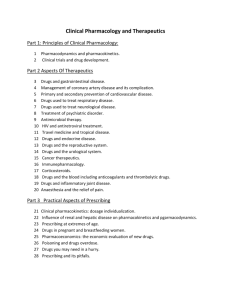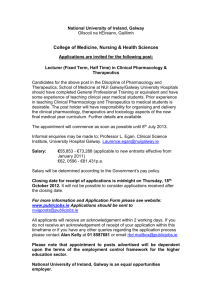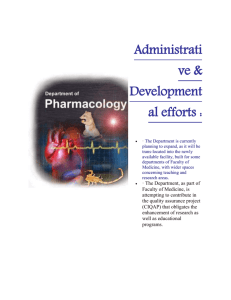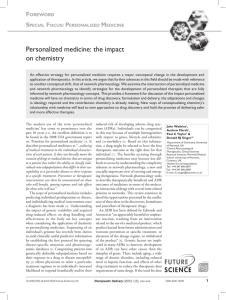Personalized medicine
advertisement
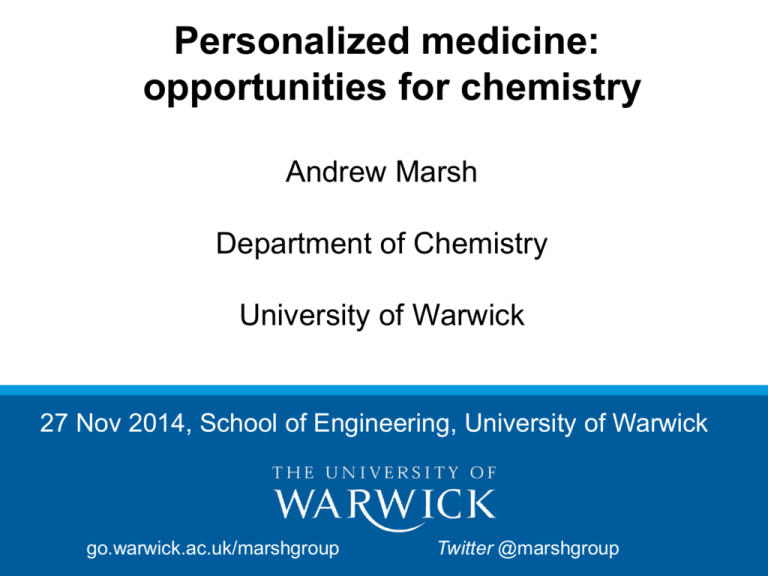
Personalized medicine: opportunities for chemistry Andrew Marsh Department of Chemistry University of Warwick 27 Nov 2014, School of Engineering, University of Warwick go.warwick.ac.uk/marshgroup Twitter @marshgroup Personalized medicine “...tailoring of medical treatment to the individual characteristics of each patient. It does not literally mean the creation of drugs or medical devices that are unique to a patient, but rather the ability to classify individuals into subpopulations that differ in their susceptibility to a particular disease or their response to a specific treatment.” Marburger JH (III); Kvamme EF, Council of Advisors on Science: Priorities for personalized medicine. (2008) “Continued adherence to a single-drug singletarget paradigm will limit the ability of chemists to contribute to advances in personalized medicine, whether they be in discovery or delivery” J Watkins, A Marsh, P C Taylor, D R J Singer Therapeutic Delivery, 2010, 1, 651-665 Human epidermal growth factor receptor 2 • ERRB2 encodes human epidermal growth factor receptor 2 (HER2) and is over-expressed in 2030% of patients with breast cancer (‘HER2+’) • Monoclonal antibody therapy trastuzumab is only effective in these patients • Parallel development of biopsy companion diagnostic test • Cardiac toxicity (2% patients) HER2/Neu complex with trastuzumab: 1N8Z.pdb Adverse drug reactions: ADRs • 7% of urgent admissions to UK hospitals due to ADRs at annual cost of GBP466M (2004) • 72% of which were avoidable • Many due to prescription of multiple therapeutics (“polypharmacy”, which has implications for new therapeutic approaches) Adverse drug reactions as cause of admission to hospital: Prospective analysis of 18 820 patients. Pirmohamed M, James S, Meakin S et al. British Med. J. 2004, 329, 15-19 Genomic testing • CYP2C9, VKORC1 SNP polymorphisms account for 30-40% in variation of warfarin anticoagulant dose required. • Genotype guided prescribing reduced all cause hospital admissions by up to 10% • HLA B*1502 allele testing in 5000 Taiwanese before carbamazepine therapy for epilepsy revealed 8% at risk of Stevens-Johnson syndrome or toxic epidermal necrosis. • No cases of those ADRs were recorded as a result of genome-guided prescribing. “The use of genotyping to inform clinical decisions about drug use is not widely practiced” ‘Genomics and Drug Response’ L Wang, H L McLeod, R M Weinshilboum New England J. Med. 2011, 364, 1144 Clinical effects Disease-relevant networks ADRs R Protein 4 Protein 1 T P Q Protein 2 CYP2D6 Oxidation by CYP2D6 to Protein 3 S QT Interval QT prolongation (HERG channel inhibition) Graphic inspired by Pujol A, Mosca R, Farrés J, Aloy P. ‘Unveiling the role of network and systems biology in drug discovery’ Trends Pharmacol. Sci. 2010, 31, 115–123. Network pharmacology view of Asthma Edges: compounds active against both targets Yellow, orange, salmon – GPCRs Blue – Ion channels Brown – nuclear hormone receptors Purple – phosphodiesterases Pink – protein kinases Network pharmacology: The next paradigm in drug discovery. Hopkins A I, Nat Chem Biol 2008, 4, 682-690 How can network pharmacology help to personalize medicines? • Challenge: linking network pharmacology and contingent pathways with personalized medicine • Opportunity: recognise that most therapeutics exhibit polypharmacology Terminology and definitions • Monotherapy – Classical ‘single target – single disease’ drug • Polypharmacology – Interaction of a small drug molecule with multiple targets • Polypharmacy – Prescription of multiple drugs • Pharmacogenomics – Study of inter-individual drug response (efficacy/toxicity) based on genetic variation Monotherapies Classically, histamine H2 receptor antagonists, e.g. cimetidine are characterised as ‘single target’ Monotherapies: one drug – one target – one disease CH3 CN N N S CH3 N H N H N H cimetidine around 1979 > USD 1bn in sales p.a. Polypharmacology – Foe or Friend? J.-U. Peters J. Med. Chem. 2013, doi:10.1021/jm400856t Polypharmacology Single entity, multi-targeted therapeutic agent: imatinib. Additional targets & indications discovered post-market CH 3 N H N N N N HN N O imatinib BCR-abl tyrosine kinase c-Kit receptor tyrosine kinase lymphocyte tyrosine kinase Polypharmacology: Many effective medicines discovered serendipitously, or from phenotypic screens Redrawn from M Shahid, G B Walker, S H Zou, E H F Wong J. Psychopharmacol. 2009, 23, 65 - 73 J R Morphy Drug Discovery Today, 2004, 9, 641 - 651 Designing Multi-Target Drugs J C Harris, J R Morphy (Eds.) 2012 Leading to a need for … Polypharmacology data can be found through ChEMBL or ChemBioNavigator … data linking therapeutics and targets O H3 C O Functional group tag and SAR study JACS 2007, 129, 12222 Ph NH O O OH O Ph O O H OH O OH O CH3 O Ph Affinity chromatography of cell lysate Chem Soc Rev 2008, 37, 1347 Photoimmobilisation ACIEE, 2003, 42, 5584 Revealing hidden phenotypes: Protein complementation assays NCB, 2006, 2, 329 Magic Tag® Chem Commun 2007, 2808 ChemMedChem 2008, 3, 742 Chem Commun 2013, 10.1039/c3cc44647f Shared side-effects Science, 2008, 321, 263 O Display libraries Chem. Biol. 1999, 6, 707-716 Knock-out organisms RNAi knock-down Small molecule microarrays Chem. Biol. 2006, 13, 493 Polypharmacy Mixtures of monotherapies: e.g. co-formulated anti-retrovirals A challenge for chemists, pharmacists and clinicians For discussion of pharmacogenetic and pharmacoecologic factors in antiviral therapy e.g. hepatitis C see: R Pavlos, E J Phillips Pharmacogenomics and Personalized Medicine 2012, 5, 1-17 How to integrate pharmacokinetic (PK) pharmacodynamic (PD) knowledge with personalized formulation and delivery? • Fixed dose combinations for known population heterogeneities • Polymers: time release technology; stabilization of biologicals • Nanostructures: design and selection of desired properties such as solubility; intracellular targeting? • Selective delivery – not magic bullets, but better understanding of cell and tissue properties; how these change with disease http://www.proteinatlas.org Pharmacology of molecular- and tissue-targeted drug action molecular target single multiple ‘Magic Bullet’ (theory) Tissue-targeted systems pharmacology multiple tissue target single ‘Magic blunderbuss’ (current practice) Polypharmacology D B Kell, S G Oliver “How drugs get into cells: tested and testable predictions to help discriminate between transporter-mediated uptake and lipoidal bilayer diffusion”, Frontiers Pharmacol. 2014, doi: 10.3389/fphar.2014.00231 Genomics and transporter pharmacology “The promiscuous binding of pharmaceutical drugs and their transportermediated uptake into cells: what we (need to) know and how we can do so” DB Kell, PD Dobson, E Bilsland, SG Oliver Drug. Disc. Today 2013, 18, 218. Database BindingdB ChEBI ChEMBL ChemProt ChemSpider DRAR-CPI Drug Adverse Reaction Target Database DrugBank iPHACE MATADOR PDSPKi PharmGKB Potential Drug Target Database (PDTD) PROCOGNATE PROMISCUOUS PubChem PubChem promiscuity SePreSA SIDER2 SuperTarget TarFisDock TDR Targets Therapeutic Target Database (TTD) Toxin, toxin-target database (T3DB) Transporter Classification DataBase (TCDB) URL http://www.bindingdb.org/bind/index.jsp http://www.ebi.ac.uk/chebi/init.do https://www.ebi.ac.uk/chembldb/ http://www.cbs.dtu.dk/services/ChemProt/ http://www.chemspider.com/ http://cpi.bio-x.cn/drar/ http://xin.cz3.nus.edu.sg/group/drt/dart.asp http://www.drugbank.ca/ http://cgl.imim.es/iphace/ http://matador.embl.de/ http://pdsp.med.unc.edu/kidb.php http://www.pharmgkb.org/ http://www.dddc.ac.cn/pdtd/ http://www.ebi.ac.uk/thorntonsrv/databases/procognate/ http://bioinformatics.charite.de/promiscuous/ http://pubchem.ncbi.nlm.nih.gov/ http://chemutils.florida.scripps.edu/pcpromiscuity http://sepresa.bio-x.cn/ http://sideeffects.embl.de/ http://bioinformatics.charite.de/supertarget/ http://www.dddc.ac.cn/tarfisdock http://tdrtargets.org http://bidd.nus.edu.sg/group/ttd/ http://www.t3db.org/ http://tcdb.org/ Drugs >180 000 >28 000 >1 million >700 000 >26 million Targets 3.673 >8.800 >30<comma>000 None 1080 6.711 739 775 236 4.227 181 - 841 >25 000 >31 million >1.600 assays 996 195 770 4.199 6219 825 814 17 816 2900 2.015 1.3 Known drug - transporter interactions for two statins atorvastatin ABCB1 ABCC1 ABCC4 ABCC5 ABCG2 SLCO1A2 SLCO1B1 rosuvastatin ABCC1 ABCC4 ABCG2 SLCO1A2 SLCO1B1 SLCO1B3 See also UCSF-FDA Transportal & Human Transporter Database DB Kell, PD Dobson, E Bilsland, SG Oliver Drug. Disc. Today 2013, 18, 218 • Which relevant transporters are present in your cell and tissue targets? 130 Defined Daily Dose statins per 1000 population UK [oecd.org Health at a Glance 2013] Modifiable factors and the individual genome Modifiable factors Disease risk: Text size proportional to risk probability Much genomic variation leads to small individual (odds ratio 1.1-1.3) benefits or risks Clinical assessment incorporating a personal genome: Ashley EA, Butte AJ, Wheeler MT et al. Lancet 2010, 375, 1525-1535 What do we need in order to achieve personalized, multi-target therapeutics? • Recognise that therapeutics act on targets within networks, rather than at the individual gene level, leading to both beneficial and adverse actions • Improved understanding of quantitative PK-PD data; use of network data in building models • Clinicians able to help chemists and engineers understand the problems faced by patients (and by clinicians in treating them!) • Need for a greater interdisciplinary approach to innovate solutions Acknowledgements • Dr Paul C Taylor, Department of Chemistry • Kate Casey-Green, Department of Chemistry • John Watkins, Dept of Chemistry; Warwick Medical School • Professor Donald R J Singer, Warwick Medical School Funding • EPSRC • University of Warwick

